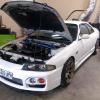R33 Rb30 Conversion
Announcements
-
Similar Content
-
Latest Posts
-
I have to put something here in order to post the photos. From what I could gather there's more enthusiasm for modified cars now than there has been for years. There were probably more younger people there than older (me included lol) which was a good sign. It did seem like the record least amount of representation of the 90's era hero cars on display though. Like maybe one or two examples of S-chassis Nissans, and maybe 3 or 4 R-chassis. By comparison there were a lot of Civics from that era but in all there were about 10 - 12 EG/EK Civic Type R. Euro exotics are always there in large numbers, led by Liberty Walk...... say what you will about kids using markers to scribble on a Ferrari F40, it did seem like a stunt to infuriate Ferrari enthusiasts, or Ferrari itself. I wonder if there's something more to it. Either way LBWK have done some heinous things to a Lamborghini Miura this time. They should stop now.
-
Stock O2 sensors are narrowband. They're useless once you're away from stoich. IE, useless for what you're trying to do. 10:1 will read the same as 14:1 from the stock O2 sensors. That is, they'll read rich. The same level of rich.
-
By joshuaho96 · Posted
I agree once misfires happen it's basically worthless, but the hope is you can see what's happening in the run up to that.
-









Recommended Posts
Create an account or sign in to comment
You need to be a member in order to leave a comment
Create an account
Sign up for a new account in our community. It's easy!
Register a new accountSign in
Already have an account? Sign in here.
Sign In Now